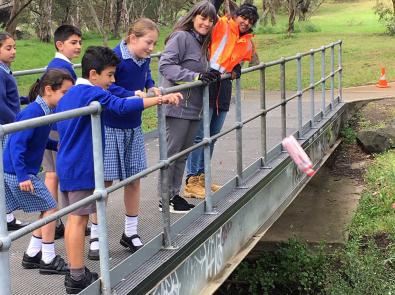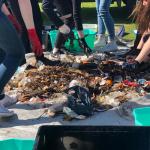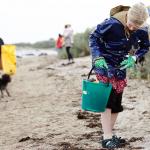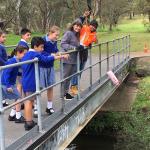Our city’s rivers and creeks receive stormwater that runs off roofs and roads in urban areas. This stormwater often contains litter carried from Melbourne’s streets. To trace the journey of litter, 100 bottles containing GPS trackers were released in creeks and rivers in Melbourne and their movements recorded.
Litter items may be trapped in stream-side vegetation, collected by litter traps, or transported along the waterway eventually ending up in Port Phillip Bay. Litter is a direct financial cost to local and state governments, and therefore to the community. It is also harmful to our wildlife in both freshwater and marine environments. The Victorian Government is working to reduce litter to protect our waterways and Port Phillip Bay.
Bottles containing Global Positioning System (GPS) trackers have been released in various creeks and rivers by schools and community groups to simulate the movement of litter through the stormwater drainage system. In all, 100 GPS-tracked bottles in 20 locations across Melbourne’s catchments have mapped precisely how litter makes its way from our streets to our beaches.
This resource is designed for students in Years 3 to 6. The case study gives an overview of the litter trackers launch and journey. Adapt the activity for your year level.
Download the lesson plan
This lesson plan contains modules explicitly linked to the Victorian Curriculum.
Activities
Activity 1: GPS trackers
Students are introduced to GPS trackers and practice using them around the school grounds.
Activity 2: Measuring time and distance
Students measure the length of time and distance of moving things online and in the school grounds.
Activity 3: Plotting the journey
Students discover the impact of rainfall, vegetation and landscape on the movement of litter in the environment.
Activity 4: Investigation
Students investigate their local waterway and the ways that litter moves through it.
Activity 5: Call to action
Students create an awareness campaign to highlight the importance of putting rubbish in the correct place.
Victorian curriculum links
- VCGGK082: Types of natural vegetation and the significance of vegetation to the environment, the importance of environments to animals and people, and different views on how they can be protected; the use and management of natural resources and waste, and different views on how to do this sustainably
Geography > Geographical knowledge > Diversity and significance of places and environments - VCGGK087: Describe and explain interconnections within places and between places, and the effects of these interconnections
Geography > Geographical concepts and skills > Place, space and interconnection - VCGGK088: Collect and record relevant geographical data and information from the field and secondary sources, using ethical protocols
Geography > Geographical concepts and skills > Data and information - VCGGK096: Environmental and human influences on the location and characteristics of places and the management of spaces within them
Geography > Geographical knowledge > Factors that shape places and influence interconnections - VCMMG143: Create and interpret simple grid maps to show position and pathways
Mathematics > Measurement and Geometry > Location and transformation - VCMMG172: Use simple scales, legends and directions to interpret information contained in basic maps
Mathematics > Measurement and Geometry > Location and transformation - VCMMG195: Choose appropriate units of measurement for length, area, volume, capacity and mass
Mathematics > Measurement and Geometry > Using units of measurement - VCMMG199: Use a grid reference system to describe locations. Describe routes using landmarks and directional language
Mathematics > Measurement and Geometry > Using units of measurement - VCMMG227: Measure, calculate and compare elapsed time
Mathematics > Measurement and Geometry > Using units of measurement - VCDSCD029: Generate, develop, and communicate design ideas and decisions using appropriate technical terms and graphical representation techniques
Design and technologies > Creating designed solutions > Generating - VCDSCD039: Generate, develop, communicate and document design ideas and processes for audiences using appropriate technical terms and graphical representation techniques
Design and technologies > Creating designed solutions > Generating
Resources
Litter action
Find out how you can stop litter at the source.
The Litter Trackers: RMIT research page
Litter is the most visible pollutant in the environment. Did you know that most of the litter on our beaches comes from suburban streets, transported through stormwater drains?
Tracking litter from our ‘burbs to the bay
To discover how precisely rubbish makes its way from these suburban streets through stormwater drains and onto our popular beaches, Melbourne Water has partnered with RMIT University to carry out a ground-breaking project.



